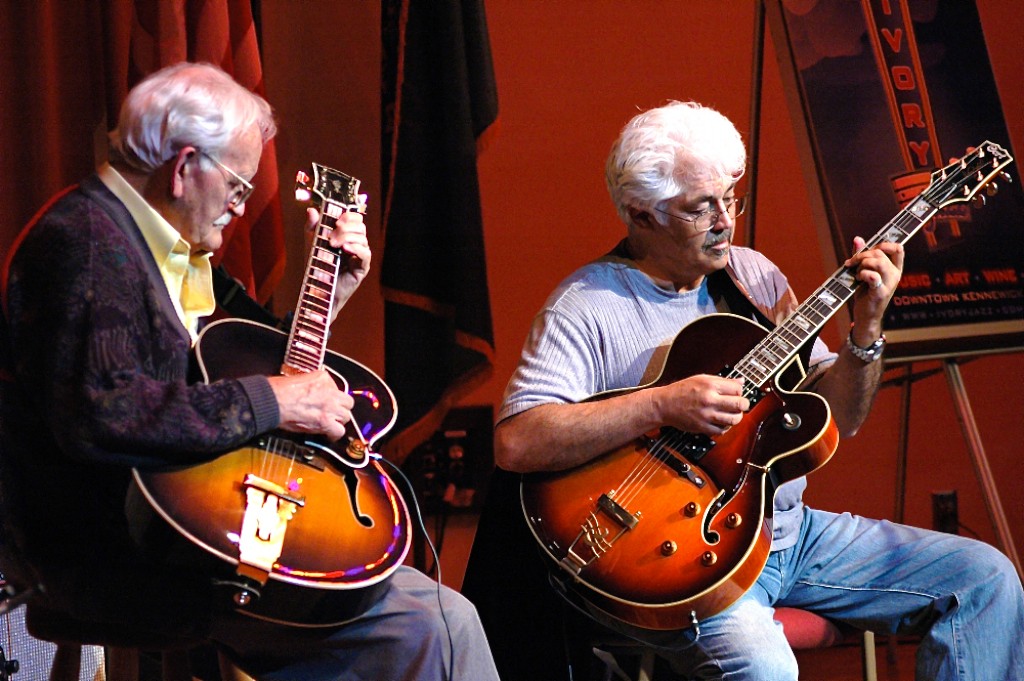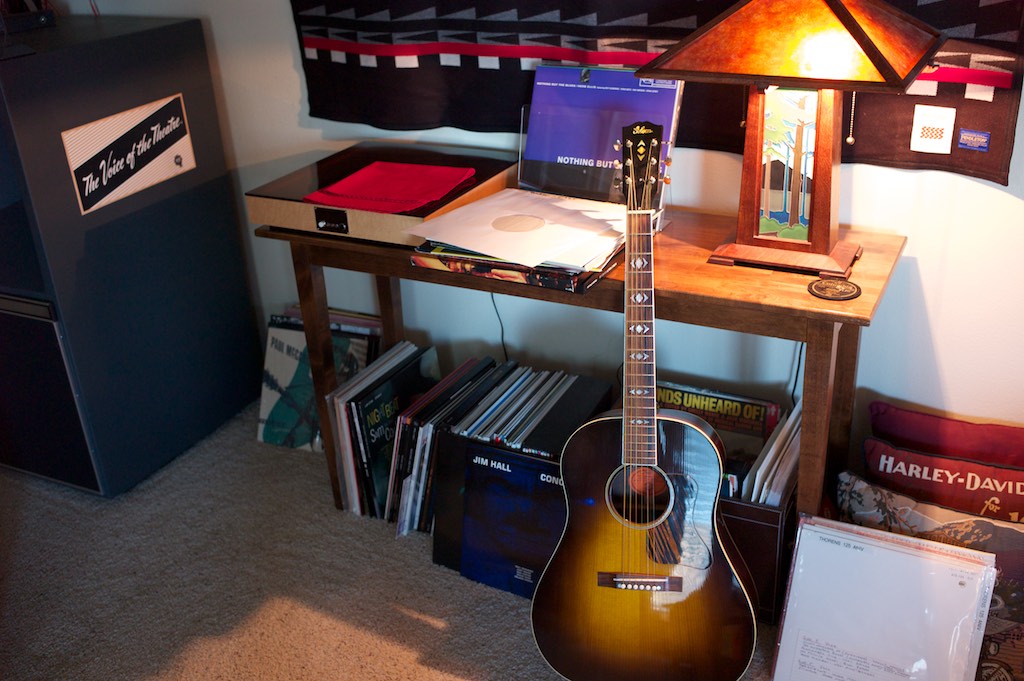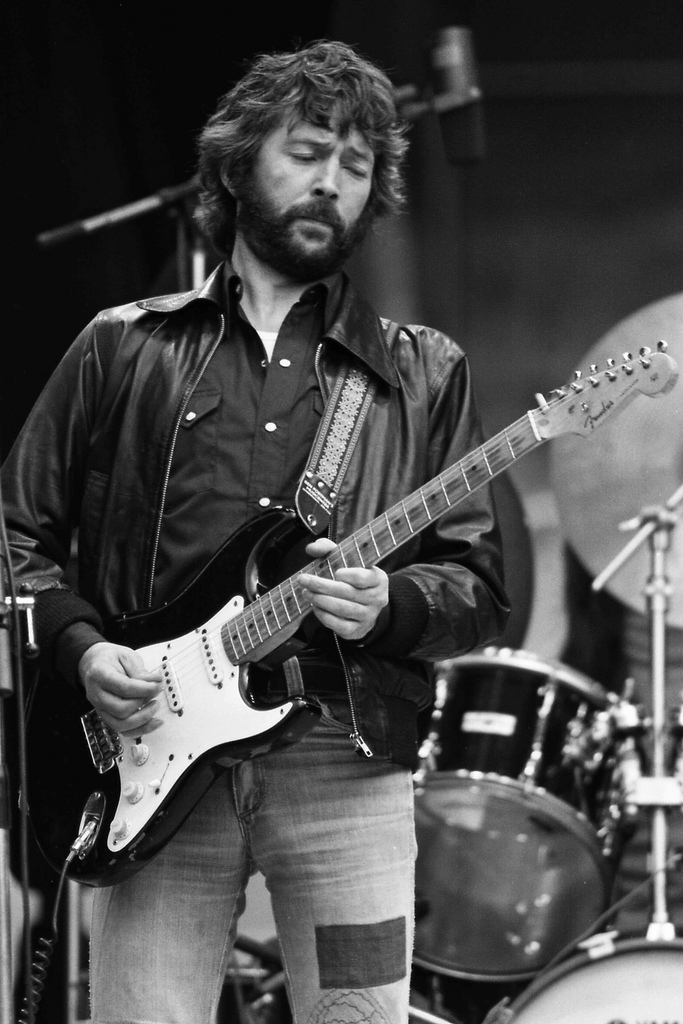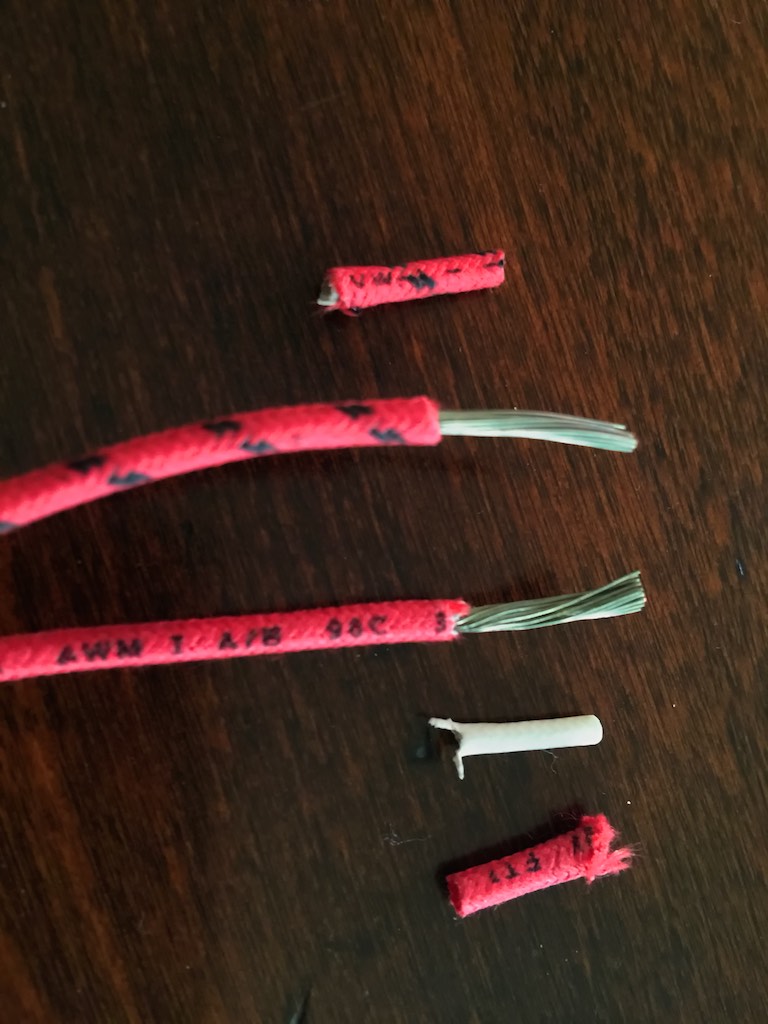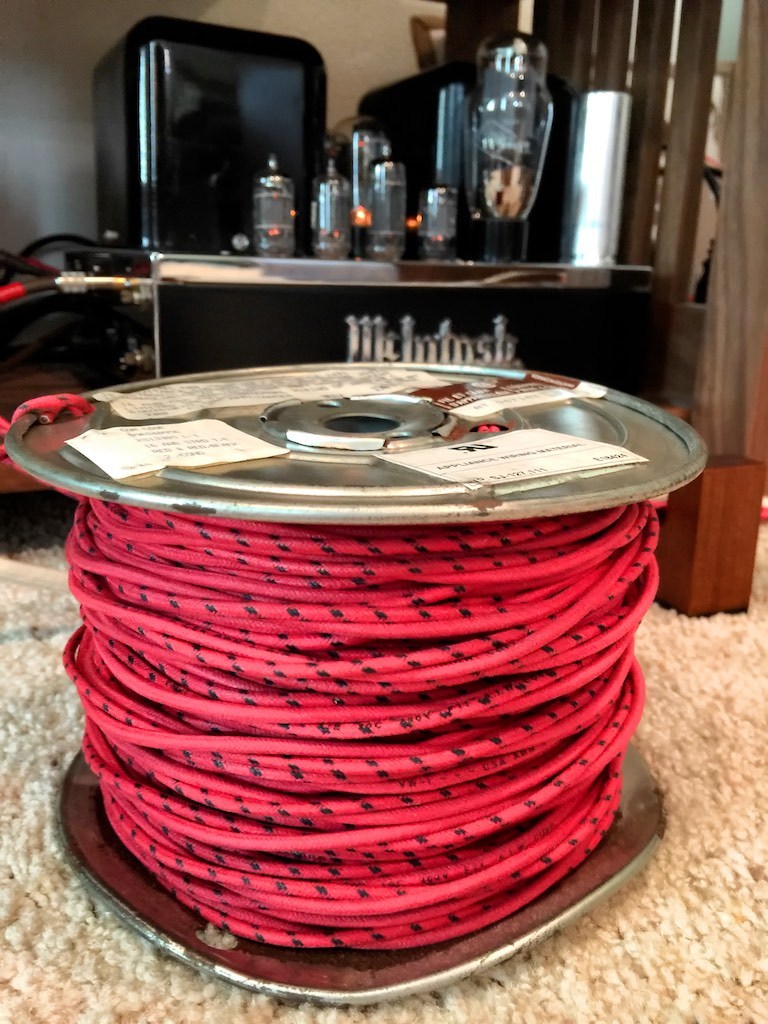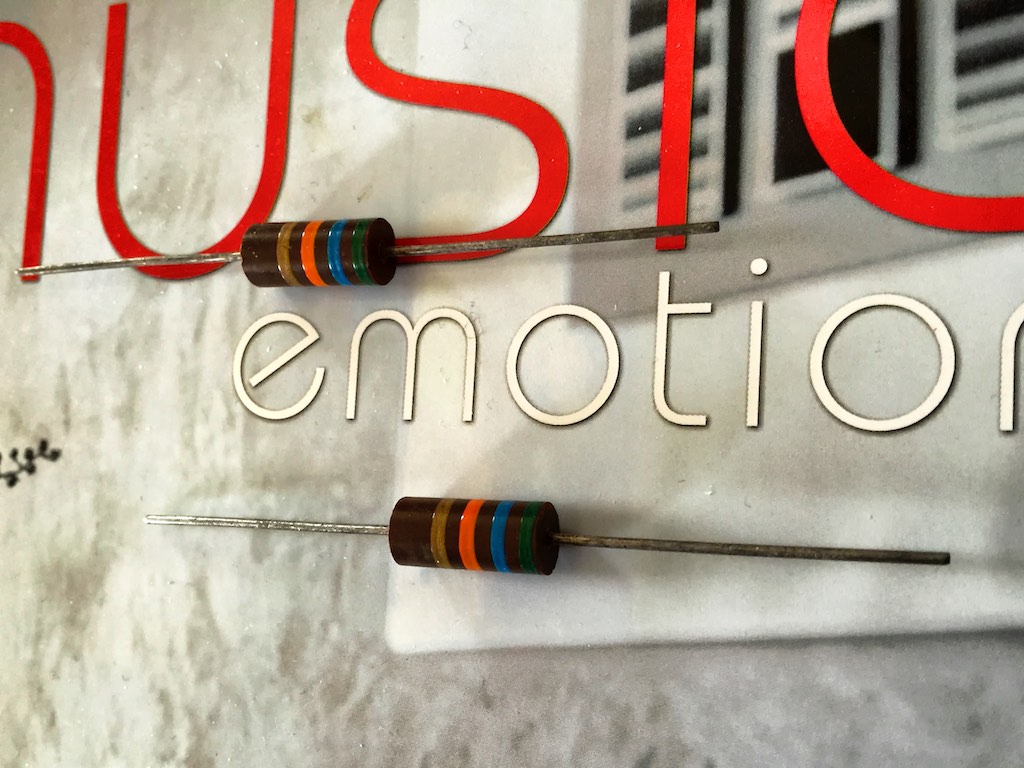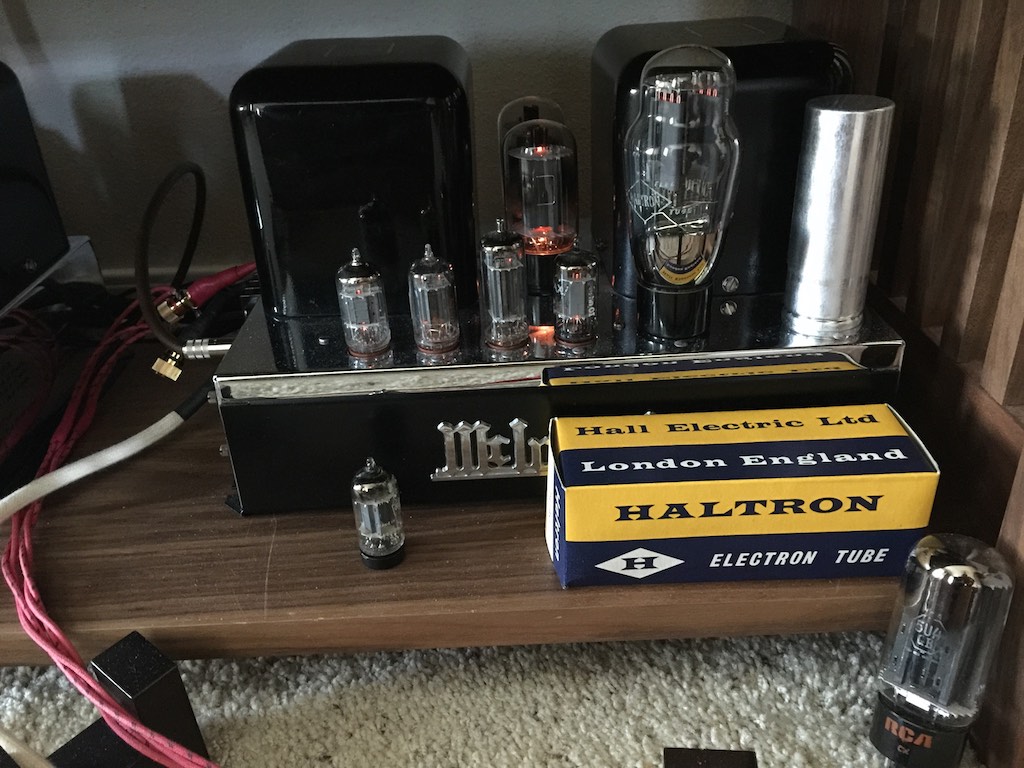I've been thinking a lot about tone lately, and in particular, vintage tone.
If you look up 'tone' in the dictionary you'll see half a dozen definitions for it, but what I'm referring to when I say 'tone' is more in line with what musician's mean when they say 'tone', and what I think music lovers & audio hobbyists mostly mean when they say 'tone', which is to say, a certain sound quality or character to the sound that enhances the beauty, meaning, spirit, artistic intent, emotional connection, etc., of the music.
Some of you know I really enjoy guitars, and at one time I spent quite a lot of time practicing & playing the guitars I have, but not so much since my guitar playing friend John La Chapelle passed away. That's John in the photo above (left), with Larry Coryell (right), a one time student of John's who would go on to considerable fame & glory due to his immense talent as a musician.
When discussing acoustic guitars 'tonewoods' are often a hot topic as they affect the 'tone' of the guitar in a very significant way. The particular wood a guitar is made out of greatly influences its overall tone, thus they are referred to as 'tonewoods'.
The Adirondack Spruce top and Brazilian Rosewood back & sides of my Gibson Advanced Jumbo are a classic pre-war vintage American guitar tonewood combination for flattop guitars that is held in high esteem by guitarists. Brazilian Rosewood is a hard, stiff, and very resonant tonewood that has a bell-like quality to it along with a lot of sustain, and when combined with the strong & clear tone of an Adirondack Spruce top, it produces an overall tone that is greatly desired by guitarists. You could refer to it as vintage tone.
As in audio, everything effects the tone of an acoustic guitar, the tonewoods used for the back, sides, and neck, as well as the strings, bridge pins, bridge saddle, and everything else.
Electric guitar players are very aware of the differences in tone between differing vintage guitars, like the Gibson Les Paul or the Fender Stratocaster, for example, or between vintage vs. modern guitars, like Eric Clapton's original custom Fender Stratocaster, Blackie, vs. the present day Fender Custom Shop Eric Clapton Signature Stratocaster that is intended to be a reproduction of it.
I've actually wanted a Fender Strat for a very long time, and one of these days I'd like to get one to play with. The most popular vintage Strat's are too expensive for my budget, but perhaps a modern Strat with the right combination of wood, neck shape, pickups, and tuners could be very enticing.
Because of this interest in vintage or notable guitars played by the guitar gods, guitar makers like Fender, Martin, and Gibson (and many others) offer guitars built similarly to particularly revered models.
If you read the guitar equivalent of audio blogs you'll find out that there is a lot of discussion about getting 'vintage tone' from modern guitars. Some guitarists think even the best 'reproduction' guitars don't attain that vintage tone of those original guitars (they're probably right), so they make changes to their guitars to get that much desired vintage tone.
With electric guitars, in addition to the woods used, the electronics have a big influence on the overall tone of the instrument, as in Eric Clapton's Fender Stratocaster shown above. Blackie's particular tonal signature is still very desired by Strat fans today. There was only one Blackie of course, as it was built from the best parts of three Stratocasters that Clapton had bought in Nashville (from Wikipedia):
"The same year, Clapton found the Sho-Bud guitar shop in Nashville, Tennessee. He bought six 1950s Stratocasters for two or three hundred US dollars each. After giving one each to George Harrison, Pete Townshend, and Steve Winwood, he took the best parts of the remaining three (built c.1956 and 1957) and Nashville Luthier Ted Newman Jones assembled "Blackie", so named for its black finish."
So let's say you were one of those lucky people who bought an Eric Clapton Signature Stratocaster that was constructed similarly to Blackie from the Fender Custom Shop. What might you do to get more vintage tone from it?
Well, for one you could wire it up with 'vintage tone pushback wire', which is a tinned copper wire with a thin poly wrap (or not) and a waxed (or not) cotton insulator.
This formula should sound somewhat familiar to fans of vintage Western Electric WE16GA wire, with its poly wrapped & cloth covered tinned copper conductors.
I made a USB interconnect out of one of the vintage tone pushback wires guitar players like to use, and it had similar tonal properties to the WE16GA, it's good stuff. It's also shockingly inexpensive compared to the prices audio hobbyists are used to paying for wire.

DIY pushback wire USB interconnect next to a Locus Design Group USB IC. The Locus has been a favorite, but I haven't been in any hurry to remove the pushback wire USB IC with its 'vintage tone'.
Another thing you could consider doing to your Blackie is to replace the stock guitar caps with the tone caps of your preference.
I've found a couple of interesting articles discussing tone caps for guitars.
The first is this very interesting article at the Guitar Pro Shop website, by Rusty Wiseman, about modifying your guitar with tone caps. The accompanying video is not to be missed, where tone caps of different compositions and values are compared with audible differences. Be sure to watch the spectrum in the right of the video change as he goes through the caps, it's very interesting.
These caps are referred to by guitarists as tone caps because they attach to the tone pot of a guitar, and because their composition & value affect the overall tone of the guitar. The guitar tone caps discussed are about a tenth of the capacitance value of the audio tone caps that I used in my vintage McIntosh MX110Z tuner-preamplifier adventure, for example, but the same sort of ideas still apply to the nature of capacitor tone effects.
This article has an interesting discussion of tone caps, and discusses how capacitors of differing composition produce different tonal qualities. Here's a summary of some of the caps discussed:
- Ceramic Capacitors: The author starts his discussion by mentioning a typical stock guitar cap, the ceramic cap, which can give grainy highs and a somewhat flat character, and says that these are the first to go for guitarists who are choosy about good tone.
- Orange Drop Capacitors: The author says Sprague/Vishay Orange Drop caps are a popular modification, and have a clear and aggressive top end, which can be complementary to certain kinds of music, like rock.
- Paper-In-Oil Capacitors: Next he discusses vintage paper-in-oil (PIO) caps and their generally smooth highs and rich sound quality.
- Polyester Film Capacitors: The author goes on to discuss polyester film capacitors like the vintage Mullard Tropical Fish capacitors. This reference was particularly interesting for me because the pairs of 0.1uF capacitors at C93 & C95 and C94 & C96 in my MX110Z had been replaced with pairs of 0.22uF Tropical Fish before it came to me. I don't know if this was done at the factory in later production, or if Terry DeWick put them in when restoring my MX110Z. Ever since Ron and I took out those Tropical Fish capacitors in the MX110 adventure, I've been pretty much chasing my tail trying to get back to that sound. It's the one that 'clicked' for me. In any event, Dirk describes Tropical Fish as "... punchy and big sounding with single coils, fattening up otherwise thin sounding guitars." One of Rusty's readers mentions that 368 Philips caps are equivalent to the Tropical Fish (although I'm not sure I believe that), so that could be worth looking into.
- Mallory Metalized Film Capacitors: The author also discusses Mallory metalized film caps, which he describes as "transparent and gorgeous with a “sweetness” to the sound".
- Sprague 'Black Beauties': Next the author describes the vintage Sprague Black Beauties as giving that deliscious warm tone to vintage Les Paul guitars (apparently Luxe makes replicas now).
Be sure to give the video associated with the above article a listen, as it is illuminating.
Dirk Wacker also gives a very nice overview of tone caps for Premier Guitar that I recommend you read as well. Check out Dirk's web site here. Here's a quick summary of the tone caps Dirk discusses:
- Sprague 'Black Beauties': Dirk describes the Black Beauties as damping the high-frequencies, "... making the tone softer, smoother, warmer or sweeter. The bass frequencies are also smoothed out, providing familiar sounds from recordings of that era." Interestingly, Dirk says, "If you want to use the vintage caps, make sure that you use vintage cloth wire inside your guitar and the Gibson fifties vintage wiring, otherwise you will not fully experience the tones from these caps."
- Sprague 'Bumblebees': Another great vintage cap that Dirk describes as being a lot like the Black Beauties. Dirk makes replicas of these in guitar sized values, but unfortunately not in audio sized values.
- 'Tropical Fish': As discussed earlier, or as Dirk says, these give 'fat tone'.
Dirk goes on to discuss 'Flat Disc' (ceramic) caps, Sprague Orange Drops, Mallory caps, silver mica caps, Styroflex caps, and paper-in-oil caps, as well as providing photos of each example. It's a great reference, check it out.
Dirk collects and sells graded vintage caps for guitarists, but doesn't have them in capacitance & voltage values suitable for audio - I asked.
Unfortunately, most of those vintage tone caps that Rusty & Dirk mention aren't made any more, and their tonal charms are largely lost to history for audio hobbyists, which is a shame. Those of you who are business oriented could probably get a specialist capacitor manufacturer (e.g. Arizona Capacitors, or someone like them) to make some custom runs of replicas of those vintage caps. The people who make replica caps for guitarists, like Luxe Radio, unfortunately don't make those caps in values appropriate for audio use. Bummer.
Ok, so where am I going with all this?
Well, partly I wanted to summarize for you some of what I've been learning about in my vintage McIntosh modification adventures, and partly I wanted to tell you about a new (to me) capacitor discovery that I want to explore in the crossovers I'm building for the Altec A5 Voice of the Theatre (VOTT) adventure I have just embarked upon.
First the McIntosh adventure summary.
Vintage Tone wire: I/we learned from Yazaki-san about the wonders of vintage Western Electric WE16GA wire, with its poly wrapped & cloth covered tinned copper conductors (as well as the neo-vintage Belden 8402 microphone cable with its tinned copper conductors).
This is what the guitar guys refer to as vintage tone wire, which is the combination of tinned copper conductors and cloth wrapped wire. This type of wire has a characteristic tonal signature associated with it that is evocative of the vintage gear that a lot of people like, whether it's guitars or the audio equipment we're talking about.
When I opened up my vintage McIntosh MC30 amplifiers guess what kind of wire it had in it? Western Electric wire with tinned copper conductors and a cloth insulator. Keep in mind what Dirk said about getting the best tone from vintage caps, that is, to experience the entire artist's palette of what these vintage caps are capable of, you have to combine them with vintage tone wire. Like McIntosh did back in vintage times.
I'm finding out that guitar guys have known about vintage tone wire for a long time, and we audio hobbyists are just rediscovering it now in a parallel universe of music loving fun & games. Many thanks to Yazaki-san for making me/us aware of the charms of vintage tone wire for audio.
Unlike with Black Beauties, Bumblebees, and Tropical Fish capacitors, I happen to know that one of the finest high-performance audio companies in the world is now prototyping vintage tone wire for audio use once again. I'm hoping it is a success and is able to make the transition from prototyping to production. I'm sworn to secrecy, but I'll tell you more when I can. It is definitely something to look forward to!
Tone Capacitors: Audio hobbyists have long chased capacitors with good tone, like the Duelund Coherent Audio capacitors I use in my Westminster Royal SE crossovers, or the Arizona Capacitors we experimented with in the vintage McIntosh DIY adventures.
Here's a link to a nice summary of audio capacitor performance at Humble Homemade Hifi.
Tone Resistors: I haven't seen any reference to the influence on tone by resistors from the guitar guys yet, so maybe they're not as much of a consideration for electric guitars.
There's are a variety of really good resistors we've tried here at Jeff's Place in the vintage McIntosh adventures, and they each have an important place in high-performance audio.
However, if it is vintage tone you're after, then vintage carbon composition resistors like the out of production vintage Allen Bradley resistors are the vintage tone meister resistors of audio. Consider the Allen Bradley's to be the vintage tone Western Electric WE16GA equivalent in the world of resistors.
Tone tubes: I've found that vintage tubes often (but not always) have the best tone. Vintage tone. In my vintage McIntosh MX110Z tuner-preamplifier, and vintage McIntosh MC30 monaural amplifiers, I'm using vintage tubes exclusively. Vintage tubes sound great! Vintage tone!
The Brent Jesse Recording website offers nice summaries of vacuum tube tone, and I recommend it as a good read for learning more about the tonal qualities of vintage vacuum tubes.
Speaking of tubes, after discussing it with Bill in a recent comment, I decided to order a pair of vintage RCA 6U8 tubes for V16 (L 3rd AF) & V17 (R 3rd AF) in my vintage McIntosh MX110 to replace the ECF82/6U8 Telefunkens that I had in those positions. I ordered the RCA 6U8's from Dale at Radio Electric Supply, which cost me $5 USD each plus $2 USD each for matching. The RCA 6U8's were recommended by Steve Hoffman on his forum for the MX110Z, and Steve was right on, they have really nice tone in my MX110 Mac, and the price was extremely reasonable!
The Altec A5 Voice of the Theatre Crossover Project
Ok, now onto the 'new' (to me) capacitors I wanted to tell you about, which I want to explore in the crossovers I'm building for the Altec A5 Voice of the Theatre (VOTT) adventure I have just embarked upon.
In my last post I described my path forward for bread boarding the new A5 VOTT crossovers, and I realized I hadn't ordered all the capacitors I needed for the project. In fact I wasn't even sure of what kind of capacitors I should order, so I sent out a message to Ron, Yazaki-san, and Pete Riggle to ask for suggestions on what to use.
Very atypically neither Ron or Yazaki-san responded to my inquiry about capacitors, but Pete did, and he told me I needed to come by his place and listen to some 'new' vintage capacitors he had found. It turned out to be serendipitous. I told Luke part of the story about this in a comment:
Hi Luke,
I was absolutely blown away by Pete Riggle’s A7 VOTTs last week. Pete built a variation of the Hiraga crossover that he adapted to the A7’s, and he used iron core inductors, so you may be on to something there. Pete’s A7 system is one of the best hi-fi systems I’ve ever heard. It was love at first listen for me.
Pete also has some capacitors that he’s discovered that area really something special, and that is part of his secret for good sound too I think. It doesn’t hurt that Pete has six decades of experience modifying and designing loudspeakers, and once owned a loudspeaker company.
His A7’s are rich, warm, musical, and utterly captivating to listen to music with. If I can get my A5’s sounding that good I’ll be in heaven!
Best,
Jeff
What I didn't go into detail about in my response back to Luke was the nature of the capacitors Pete wanted me to hear in his Hiraga-style crossovers for his A7 VOTTs.
If you've read the comments here at Jeff's Place carefully over time, you may remember Pete Riggle confessing his fondness for Ronken P61 style of industrial capacitors. They're big, clunky looking, rugged industrial capacitors that use 'wetmet' film & metalized paper in oil (see the photo of the Ronken catalog page below). They are also relatively inexpensive out at Tedss.
Ronken (and other companies) made these style of rugged industrial capacitors, and they're commonly referred to as 'motor run' capacitors.
The Ronken P61 'wetmet' oil-filled capacitors are now out of production and rather hard to come by, and have been replaced now by current production 'filmet' Ronken P91 series capacitors, which are a metalized polypropylene (I think in oil) capacitor.
Ronken also made 'all-film' P64 series industrial commutation capacitors, the 'all-paper' in oil P71 series of industrial capacitors, P81 series of 'film-paper' in oil industrial capacitors, and the P86 'film-paper' in oil industrial commutation capacitors.
Well it turns out that these early Ronken P61 (and perhaps other) industrial motor run capacitors are the Black Beauty, Bumblebee, and Tropical Fish tone capacitors of the industrial capacitor world.
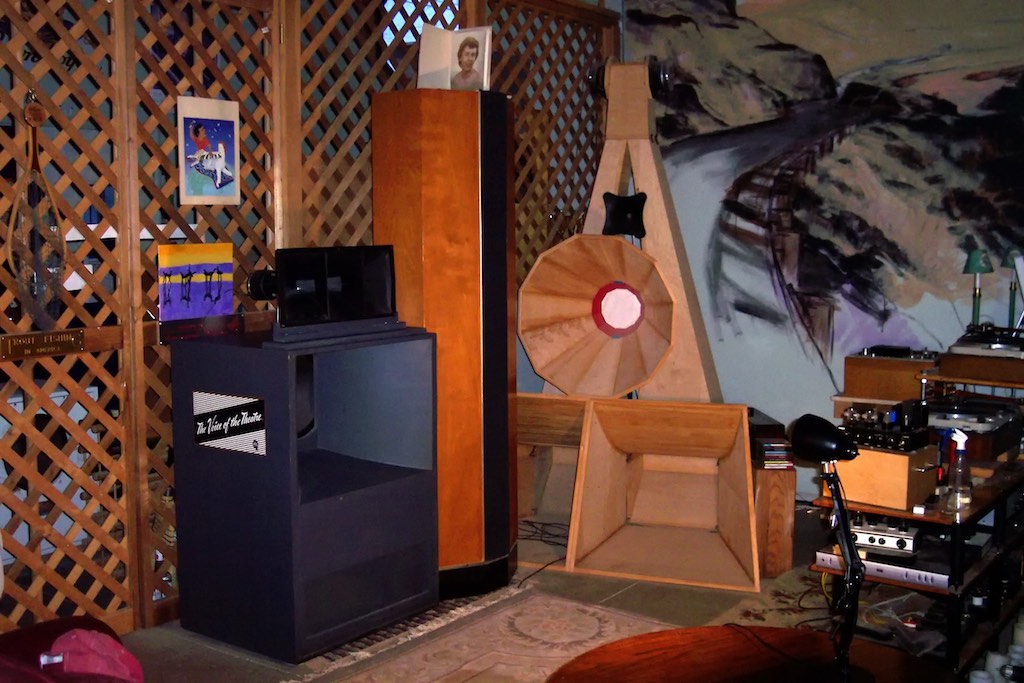
Pete's A7 VOTTs resting on the sidelines. Pete's listening room is a giant Faraday cage, which I think is really cool. It's an engineer thing.
Pete's set of Hiraga-style crossovers for his A7's were built up with a nearly full set of the Ronken P61 'wetmet' industrial capacitors and the result is stunning. I don't know if I've ever heard anything that approached the sheer musicality of Pete's A7 VOTT system with those Ronken P61 caps. The resulting tone was rich, smooth, colorful, with a palpable sensuality to it, and the most emotionally engaging experience I may ever have had listening to music.
I was so beside myself I forgot to take pictures, so I subbed in an old photo above. I don't know what I was expecting, but I wasn't expecting the most musically engaging and achingly realistic & beautiful reproduction of music that I've maybe ever heard.
Then Pete swapped out the P61's he used in the high-frequency portion of the Hiraga circuit with another 'secret' style of industrial 'motor run' capacitor he discovered, and the performance went to another level, while my jaw fell to the floor. Pete's so amazed (me too) by these new capacitors he discovered that he's bought a large stock of them, with the idea of grading them and offering them for sale for crossover projects. I'll keep you posted as I hear more about that from Pete.
These crazy industrial 'motor run' capacitors have absolutely gorgeous vintage tone. Pete suggested I start with the Ronken P61 'wetmet' caps in my A5 VOTT crossover project to get a feel for what they can do, and given what I had just experienced at Pete's place, I ordered up what I needed from Tedss lickety split.
Tedss didn't have the P61's in all the values I needed, but they had most of them. For the P61's values they didn't have at Tedss, I ordered some similar capacitors with the values I needed (which I'll provide more details about in the future).
Then I started bread boarding in earnest. At the moment I am just laying out the circuit and trying to get a feel where everything should go.
I'll have much more to say about these industrial tone capacitors as time goes on and I get a better handle on what they're capable of. With a little luck I'll get to try some of Pete's special discovery caps too. At the moment I'm very impressed, and just hoping I can get performance similar to what Pete was getting at his place, which I found to be incredibly satisfying.
Much more to come, and may the tone be with you!
Thanks for stopping by!




